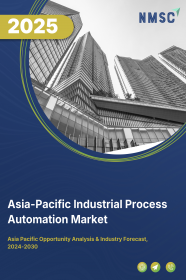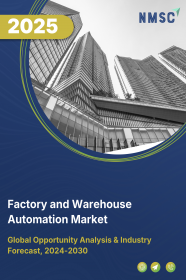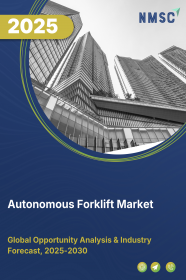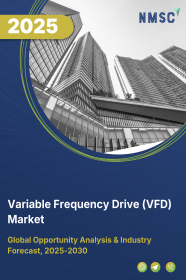
Asia-Pacific Industrial Process Automation Market by Component (Manufacturing Execution System (MES), Distributed Control System (DCS), Programmable Logic Control (PLC), Supervisory Control & Data Acquisition (SCADA), Field Instruments, Industrial Robots, and Process Analyzers and Drives), and by End-User (Oil & Gas, Chemical & Refining, Energy & Power, Pulp & Paper, Metals & Mining, Pharmaceutical, Cement & Glass, and Others) – Opportunity Analysis and Industry Forecast, 2024–2030
Industry: Semiconductor & Electronics | Publish Date: 17-Feb-2025 | No of Pages: 173 | No. of Tables: 110 | No. of Figures: 75 | Format: PDF | Report Code : SE988
US Tariff Impact on Asia-Pacific Industrial Process Automation Market
Trump Tariffs Are Reshaping Global Business
Asia-Pacific Industrial Process Automation Market Overview
The Asia-Pacific Industrial Process Automation Market size was valued at USD 18.17 billion in 2023, and is predicted to reach USD 32.43 billion by 2030, at a CAGR of 8.1% from 2024 to 2030.
The industrial process automation sector encompasses the industry that delivers technologies and systems aimed at monitoring, controlling, and optimizing industrial operations. It integrates advanced computer technologies, hardware, and software to automate essential processes such as inventory management, manufacturing, production, and quality control.
Key technologies driving this market include sensors, programmable logic controllers (PLCs), human-machine interfaces (HMIs), and supervisory control and data acquisition (SCADA) systems. This market caters to industries such as oil and gas, chemical processing, food and beverage, and pharmaceuticals, where automation plays a critical role in enhancing efficiency, product quality, and workplace safety.
By reducing costs and minimizing human errors, industrial process automation allows companies to streamline production, resulting in higher output with greater accuracy. As businesses increasingly seek to boost productivity and stay competitive in a rapidly automating global manufacturing landscape, the demand for process control systems continue to rise.
Rising Automation Adoption in Key Industries Drives the Market Growth
The increasing implementation of automation technologies in critical industries such as oil & gas, pharmaceuticals, food & beverages, power generation, and chemicals is driving significant growth in the industrial process automation market in the Asia-Pacific region.
As companies across China, Japan, India, and South Korea adopt these technologies, they are able to streamline operations, reduce manual labor, and boost precision and productivity. This shift towards automation enhances overall efficiency and accelerates production processes, contributing to the expanding Asia-Pacific industrial process automation market.
Government Investments and Technological Advancements Boost Automation Demand
Governments in the Asia-Pacific region are emphasizing energy independence and investing in renewable energy sources to cut greenhouse gas emissions and foster sustainable development.
At the same time, the adoption of Industry 4.0 technologies is rising in countries such as India, South Korea, and Indonesia. These technologies enable real-time monitoring and control of industrial processes, leading to better optimization and efficiency.
As a result, the Asia-Pacific industrial process automation market demand is increasing, driven by both governmental support and the need for advanced technological solutions in various industries.
Lack of Standardization Hinders the Growth of Industrial Process Automation Market
The lack of standardization is a major challenge that can limit the Asia-Pacific industrial process automation market growth. Without common standards, vendors may develop proprietary systems that are hard to replace or upgrade. This can result in vendor lock-in, where companies become dependent on a specific vendor’s technology, restricting their ability to switch to other vendors.
Vendor lock-in often leads to increased costs, reduced flexibility, and less innovation, that negatively affect market growth. Companies might hesitate to invest in automation systems if they are worried about being tied to one vendor’s technology, further slowing market expansion.
Industry 4.0 Technologies Paving the Way for Future Automation Opportunities
Advancements in Industry 4.0 technologies, such as the Internet of Things (IoT), cloud computing, and artificial intelligence (AI), are opening up significant opportunities for the Asia-Pacific industrial process automation market trends.
These automation technologies allow companies to gather and analyze large amounts of data in real-time, offering valuable insights into their operations and highlighting areas for improvement. As technology evolves quickly, market participants are partnering with tech-focused companies to create new solutions based on established technologies.
China Holds the Dominant Market Share in Asia-Pacific Industrial Process Automation Market
Government initiatives are playing a pivotal role in accelerating the growth of the Asia-Pacific industrial process automation market. The "Made in China 2025" plan, for example, focuses on modernizing the manufacturing sector by integrating advanced technologies such as Manufacturing Execution Systems (MES), Distributed Control Systems (DCS), and Human-Machine Interfaces (HMI).
This emphasis on technology integration is enabling industries such as oil & gas, power generation, and chemicals to improve operational efficiency and reduce manual labor. As businesses adopt these systems to enhance productivity, the demand for automation solutions rises, driving significant growth in the industrial process automation sector of Asia-Pacific region. This government-led push for modernization is directly contributing to the advancement of automation technologies, strengthening the overall market development.
The ambitious energy reduction and carbon neutrality goals are driving significant demand for process optimization as the world's largest energy consumer aims for carbon neutrality by 2060, the adoption of advanced automation systems such as Distributed Control Systems (DCS), Programmable Logic Controllers (PLC), and Supervisory Control and Data Acquisition (SCADA) becomes crucial.
These technologies are essential in sectors such as manufacturing and power generation, where they improve operational control, enhance productivity, and lower energy consumption and carbon emissions through real-time monitoring and analysis. This push towards sustainability is accelerating the need for automation solutions, thereby fueling growth in the market.
Japan to Witness Substantial Growth in the Asia-Pacific Industrial Process Automation Market
The automotive industry’s reliance on industrial process automation systems is crucial for enhancing production efficiency, cutting costs, and ensuring high product quality. In Japan, a key player in the automotive sector, manufacturers are increasingly adopting technologies such as robotics, Programmable Logic Controllers (PLC), and Supervisory Control and Data Acquisition (SCADA) to streamline production.
These automation systems help mitigate labor shortages, reduce manual labor, and manage operational costs effectively. They also ensure consistent product quality, that is essential for meeting the growing demand for vehicles, especially electric vehicles.
By integrating automation, Japanese manufacturers can boost productivity, maintain global competitiveness, and adapt to the shifting market demands. This trend is driving significant growth in the industrial process automation industry within Japan.
The rising government initiatives in Japan, including the Robot Revolution Initiative and the Society 5.0 vision, are actively promoting the adoption of automation technologies. These policies encourage the use of advanced systems such as Distributed Control Systems (DCS), Programmable Logic Controllers (PLC), and Supervisory Control and Data Acquisition (SCADA) to enhance productivity, efficiency, and safety across various sectors.
In particular, Japan’s energy and power industry faces challenges from aging infrastructure and environmental concerns, creating a pressing need for reliable automation systems to manage and monitor complex processes in power generation and distribution. These factors collectively drive the growing demand for industrial process automation systems, accelerating market expansion.
Competitive Landscape
Several key players operating in the Asia-Pacific industrial process automation industry include Siemens AG, Honeywell International, Schneider Electric, Mitsubishi Electric, Rockwell Automation, Emerson Electric Co., ABB Ltd., Omron Corp., Fanuc Corp., Toshiba Corp., and others.
Asia-Pacific Industrial Process Automation Market Key Segments
By Component
-
Manufacturing Execution Systems
-
Hardware
-
Software
-
Services
-
-
Distributed Control Systems
-
Hardware
-
Software
-
Services
-
-
Programmable Logic Control
-
Hardware
-
Software
-
Services
-
-
Supervisory Control and Data Acquisition (SCADA)
-
Hardware
-
Software
-
Services
-
-
Field Instruments
-
Industrial Robots
-
Process Analyzers & Drives
By End-User
-
Oil & Gas
-
Chemical & Refining
-
Energy & Power
-
Pulp & Paper
-
Metals & Mining
-
Pharmaceutical
-
Cement & Glass
-
Others
By Country
-
China
-
Japan
-
India
-
South Korea
-
Australia
-
Indonesia
-
Singapore
-
Taiwan
-
Thailand
-
Rest of Asia-Pacific
Key Players
-
Siemens AG
-
Honeywell International
-
Schneider Electric
-
Mitsubishi Electric
-
Rockwell Automation
-
Emerson Electric Co.
-
ABB Ltd.
-
Omron Corp.
-
Fanuc Corp.
-
Toshiba Corp.
REPORT SCOPE AND SEGMENTATION:
|
Parameters |
Details |
|
Market Size in 2023 |
USD 18.17 Billion |
|
Revenue Forecast in 2030 |
USD 32.43 Billion |
|
Growth Rate |
CAGR of 8.1% from 2024 to 2030 |
|
Base Year Considered |
2023 |
|
Forecast Period |
2024–2030 |
|
Market Size Estimation |
Billion (USD) |
|
Growth Factors |
|
|
Countries Covered |
10 |
|
Companies Profiled |
10 |
|
Market Share |
Available for 10 companies |
|
Customization Scope |
Free customization (equivalent up to 80 working hours of analysts) after purchase. Addition or alteration to country, regional, and segment scope. |
|
Pricing and Purchase Options |
Avail customized purchase options to meet your exact research needs. |

















 Speak to Our Analyst
Speak to Our Analyst



















